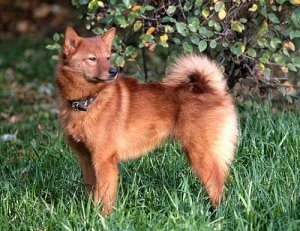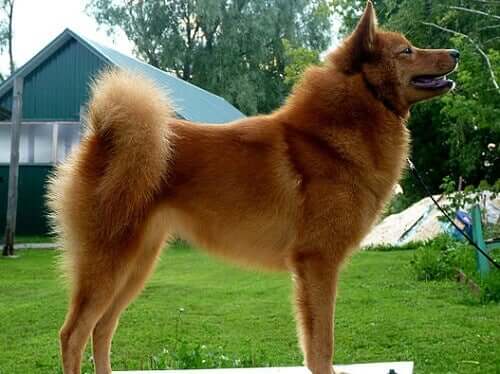Discover the Elegance of the Finnish Spitz


Written and verified by the lawyer Francisco María García
The Finnish Spitz, which you may also know as the Finkie, is a typical breed from the Nordic region of Europe. It originates specifically back to Finland and belongs to the secular Spitz family. This breed is among the oldest breeds still present in western culture.
The origins of the Finnish Spitz
The story of this elegant canine breed involves the myths that exist about wolf-dogs. The story goes that the first specimens of the Finnish Spitz were the result of natural crossing among the wolf-dogs of the peat bogs.
Apparently, this “wolf-dog” was the first of its kind – the first wolf-dog hybrid to live alongside man. Historical records lead us to believe that the peat bog wolf-dog began to accompany men from the lake-filled regions of Nordic Europe more than 10 thousand years ago.
Over the years, the appearance of this breed has changed and modified, resulting in what we know today as the Finnish Spitz.
The Finnish Spitz: A breed with many historic transformations
The Finnish Spitz, just like most of the breeds from its family, stands out for its excellent hunting skills. In the 1970s, Finland chose this particular breed as its national dog.
The past involves many historical changes that brought this breed almost to the point of extinction. The first Finnish Spitz specimens traveled to Europe with tribes that originally came from Eurasia. Their journey finally ended in Finland.
The arrival of other breeds to the Nordic regions and the genetic crossings put the dog under threat of extinction.
Around the middle of the 19th century, specimens that had never mixed with other breeds were discovered.
These dogs acted as the true saviors of their breed. Experts rescued them, protected them, and encouraged them to breed in a controlled environment. Their efforts led to the preservation of the purity of the breed and saved the Finnish Spitz from disappearing altogether.
The evolution of the Finnish Spitz to date
The beginning of professional breeding in the United States allowed the Finnish Spitz to later earn recognition as a breed by the American Kennel Club in the 80s.
When it comes to smell, chasing, learning, and adapting to life with humans, its qualities are endless. And, thanks to these qualities, it has proven to be a very useful dog. Over the years, these dogs have served by hunting small rodents and certain birds.
To date, the Finnish Spitz continues to hunt squirrels and capercaillies in its home country of Finland. In the United States, it’s enjoyed success mainly as a companion dog. Today, you can come across these beautiful dogs all over Europe and America.

In regards to the genetic wolf heritage, these dogs stand out for their mild and lively nature. What’s more, they learn quite easily. They get along well with children and develop a strong devotion to their families. Among Nordic dogs, the Finnish Spitz is the most active.
What are the main characteristics of the Finnish Spitz?
As for its physique, it tends to be medium in size and has a square build. They are athletic in structure, but skinnier than other Nordic dogs. Its noble appearance communicates livelihood and kindness. At first glance, it’s easy to confuse these dogs with foxes, although they aren’t at all related.
They possess a narrow head and triangle-shaped ears that are hairy and stand up straight. These canines possess an abundant amount of hair, composed of a double coat, which keeps their bodies warm in cold temperatures. Therefore, they adapt well to cold climates. At the same time, they may exhibit changes in behavior when exposed to very high temperatures.
The external and visible layer of fur on the Finnish Spitz is long, thick, and shiny. For the most part, they are reddish in color.
The males among this species have an average height of between 17 and 20 inches. As for females, they are between 15 and 18 inches tall. The average weight of these dogs varies between 31 and 35 pounds in males, and 24 and 27 pounds in bitches.
The life expectancy of these dogs is approximately 12 years. They are not prone to any serious or genetic illnesses. However, some specimens may experience kneecap dislocations or epilepsy on rare occasions.
Caregivers must provide specific care when it comes to the hair and skin of these dogs. Their hair needs to stay dry in order to keep moisture from building up. Otherwise, this moisture can lead to the reproduction of microorganisms.
The Finnish Spitz has the temperament of a typical hunting dog. It’s very energetic and fast, and needs large outdoor spaces in order to get enough exercise.
Source of images: Karelgerda y Karelka-layka
The Finnish Spitz, which you may also know as the Finkie, is a typical breed from the Nordic region of Europe. It originates specifically back to Finland and belongs to the secular Spitz family. This breed is among the oldest breeds still present in western culture.
The origins of the Finnish Spitz
The story of this elegant canine breed involves the myths that exist about wolf-dogs. The story goes that the first specimens of the Finnish Spitz were the result of natural crossing among the wolf-dogs of the peat bogs.
Apparently, this “wolf-dog” was the first of its kind – the first wolf-dog hybrid to live alongside man. Historical records lead us to believe that the peat bog wolf-dog began to accompany men from the lake-filled regions of Nordic Europe more than 10 thousand years ago.
Over the years, the appearance of this breed has changed and modified, resulting in what we know today as the Finnish Spitz.
The Finnish Spitz: A breed with many historic transformations
The Finnish Spitz, just like most of the breeds from its family, stands out for its excellent hunting skills. In the 1970s, Finland chose this particular breed as its national dog.
The past involves many historical changes that brought this breed almost to the point of extinction. The first Finnish Spitz specimens traveled to Europe with tribes that originally came from Eurasia. Their journey finally ended in Finland.
The arrival of other breeds to the Nordic regions and the genetic crossings put the dog under threat of extinction.
Around the middle of the 19th century, specimens that had never mixed with other breeds were discovered.
These dogs acted as the true saviors of their breed. Experts rescued them, protected them, and encouraged them to breed in a controlled environment. Their efforts led to the preservation of the purity of the breed and saved the Finnish Spitz from disappearing altogether.
The evolution of the Finnish Spitz to date
The beginning of professional breeding in the United States allowed the Finnish Spitz to later earn recognition as a breed by the American Kennel Club in the 80s.
When it comes to smell, chasing, learning, and adapting to life with humans, its qualities are endless. And, thanks to these qualities, it has proven to be a very useful dog. Over the years, these dogs have served by hunting small rodents and certain birds.
To date, the Finnish Spitz continues to hunt squirrels and capercaillies in its home country of Finland. In the United States, it’s enjoyed success mainly as a companion dog. Today, you can come across these beautiful dogs all over Europe and America.

In regards to the genetic wolf heritage, these dogs stand out for their mild and lively nature. What’s more, they learn quite easily. They get along well with children and develop a strong devotion to their families. Among Nordic dogs, the Finnish Spitz is the most active.
What are the main characteristics of the Finnish Spitz?
As for its physique, it tends to be medium in size and has a square build. They are athletic in structure, but skinnier than other Nordic dogs. Its noble appearance communicates livelihood and kindness. At first glance, it’s easy to confuse these dogs with foxes, although they aren’t at all related.
They possess a narrow head and triangle-shaped ears that are hairy and stand up straight. These canines possess an abundant amount of hair, composed of a double coat, which keeps their bodies warm in cold temperatures. Therefore, they adapt well to cold climates. At the same time, they may exhibit changes in behavior when exposed to very high temperatures.
The external and visible layer of fur on the Finnish Spitz is long, thick, and shiny. For the most part, they are reddish in color.
The males among this species have an average height of between 17 and 20 inches. As for females, they are between 15 and 18 inches tall. The average weight of these dogs varies between 31 and 35 pounds in males, and 24 and 27 pounds in bitches.
The life expectancy of these dogs is approximately 12 years. They are not prone to any serious or genetic illnesses. However, some specimens may experience kneecap dislocations or epilepsy on rare occasions.
Caregivers must provide specific care when it comes to the hair and skin of these dogs. Their hair needs to stay dry in order to keep moisture from building up. Otherwise, this moisture can lead to the reproduction of microorganisms.
The Finnish Spitz has the temperament of a typical hunting dog. It’s very energetic and fast, and needs large outdoor spaces in order to get enough exercise.
Source of images: Karelgerda y Karelka-layka
This text is provided for informational purposes only and does not replace consultation with a professional. If in doubt, consult your specialist.








